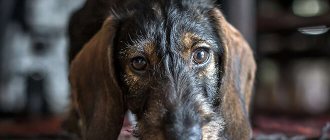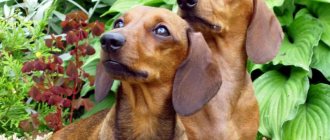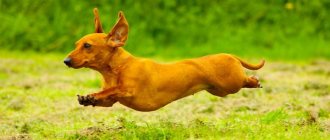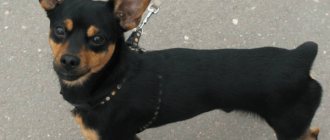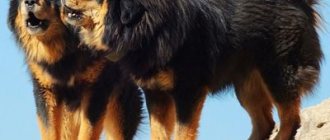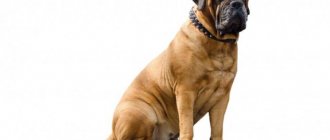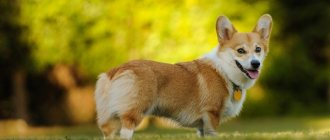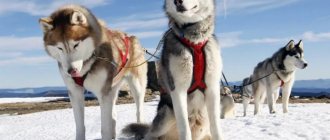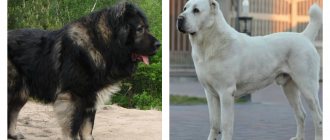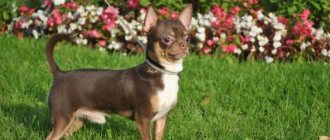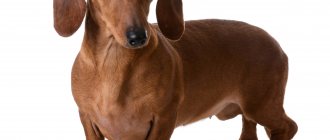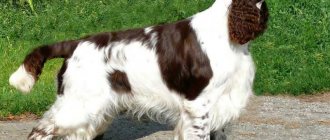Dachshund and history of the breed
Dachshund breeds were developed by crossing a spaniel and a smooth-haired dachshund. In some cases, pointer breeds were used instead of spaniels. The first mentions of long-haired representatives in the literature appeared in 1820, and breeding experiments aimed at size began to be carried out in 1836.
In the USSR, long-haired representatives appeared in the post-war years. Dogs were imported and the origins of most animals were unknown. Since the 80s, among long-haired dachshunds bred in Moscow, there has been a sharp decline in working qualities. Those dog breeders who did not hunt at all began to purchase animals.
Gradually, the long-haired dachshund turned into a pet playing a purely decorative role. The dwarf or rabbit variety is best suited for a city dweller, which is why recently such dachshunds are most in demand and are bred in huge quantities.
- Dachshund breeds are prescribed by a certain standard. According to it, all dogs differ in conformation standards and coat size. In the mid-19th century, the breed was bred without division by coat.
This variety was obtained by combining the smooth-haired dachshund and representatives of breeds with bristly and rough hair, in particular several types of terriers, such as the Scottish and English, as well as the Dandie Dinmont.
History of the origin of dachshunds
The dachshund is originally from Germany and was probably developed in the Middle Ages. Official farms have existed since the late 16th century, but the standard was only established in 1925. These dogs were faithful companions of hunters and were at the peak of their popularity during the hunt for badgers and foxes. Their short legs allowed them to enter the holes of badgers and foxes to get them out. However, they did not have to fight these animals in the forest. Besides their ability to win at the game, the breed is known for many qualities. Her main abilities include tracking down tracks. However, it has become common to adopt a Dachshund as a pet dog.
Interesting fact: Napoleon Bonaparte was one of the most loyal fans of the breed. Indeed, he enjoyed being represented in paintings with dachshunds, and even gave one of his four-legged friends the name “Napoleon.” His companions found their final resting place next to the grave of their master.
Because of its status as a hunting dog, the dachshund was long valued by the nobility. Emperor Wilhelm II built a monument to Erdmann, his beloved dachshund, with the inscription: "Remembering my faithful dachshund Erdmann (1890–1901)."
Queen Elizabeth II, whose passion for corgis is well known, could not resist the charm of this short-legged dog. She even bred "dorgis", dogs at the crossroads between dachshunds and corgis (a neologism made up of the English word "dachshund" and the word "corgi").
If you trace the origins of the dachshund, it turns out that some artists valued these dogs and found a source of inspiration in them. The artist Pablo Picasso and his dachshund Lump were considered inseparable, as evidenced by numerous photographs of the duo. Artist Andy Warhol also featured his dogs Archie and Amos in many of his works.
Predominantly the dog of the nobility, the dachshund captured the hearts of dog friends in Europe and even beyond. Especially in Germany, this dog met with great success and its popularity grew rapidly. The Summer Olympics in Munich in 1972 clearly contributed to its popularity throughout the world. Their mascot was a colored dachshund named Waldy. Today, such dogs have become less and less common on the street.
Dachshund and description of the breed by degree of separation
According to the degree of coat, they are divided into three types:
- With smooth coat;
- With hard hair;
- With long hair.
Varieties
Within each of these varieties, three more groups are distinguished, based on size:
- Standard – the largest;
- Dwarf - slightly smaller in size;
- Rabbits are the smallest;
Not all varieties were formed naturally; selection methods were often used. Since the dachshund was originally used to chase badgers, the development of one or another type of breed depended on hunting specialization, natural conditions and the specific animal being hunted.
- A standard dachshund stands between 20 and 27 cm in height, weighs about 9 kg and has a chest circumference of 35 cm.
- The dwarf type is smaller in size - 14-21 cm; upon reaching 15 months, her chest circumference is 30-35 cm.
- The smallest dog of all presented is the rabbit dachshund, its size does not exceed 15 cm, and when it reaches 15 months, its chest circumference is 30 cm.
Standard
Dachshund dogs are of classic size, the most common of all representatives. Smart, purposeful, with an inexhaustible flow of energy.
- The chest volume does not exceed 34 – 35 cm;
- Weight of an adult dog: 8 – 9 kg.
Suitable as a family favorite and for singles. Will be a companion for all categories of people. Emotional, with a pronounced hunting instinct. Can live with other pets.
Dwarf or miniature
Almost twice as small as the classic size. Highly intellectually developed, smart, ideally trainable.
- Chest volume: 33 – 34 cm;
- Weight: 4 – 6 kg.
Easy to care for and maintain, it can live in a family with small children and other pets. Active, hardy, curious, a wonderful companion.
Rabbit representative
A rare find, less common among all its brethren. Baby rabbit, specially bred for hunting and the ability to get into small holes. The instinct of the hunter is clearly expressed. On walks, this emotional, loyal, kind dog can run and track small animals.
- Chest: 30 – 32 cm;
- Weight: up to 4 kg.
The most active of all, requires early socialization, as well as strict education and training. It will feel great in even a small apartment.
Dachshund dog - a brief description of the breed
The dachshund is a small dog, easy to care for, hardy and friendly. This animal always captivates and wins you over after the first meeting. Expressive eyes seem to look straight into the soul, and sincere interest evokes a reciprocal smile.
Thanks to its many positive qualities and wonderful character, the dachshund is popular not only among hunters, but also among ordinary dog breeders.
The dachshund is considered a burrowing animal, and it was bred to hunt badgers, foxes and other living creatures that had to be taken out of holes.
Coat color and coat length
The color of the Dachshund breed is red, coffee, and black and tan. Mixed with the red tint, you can see reddish and dark cherry colors. There are rich chestnut, light red and bright golden colors.
The “moiré” shade has become very popular among dog breeders. In it, the upper part of the hair is black, and closer to the bottom it turns golden. Dark shades stand out most on the sides, with splashes on the ears or shoulders. The underside of the dachshund's body is predominantly golden in color. Outwardly, it looks like a black veil neatly applied to a reddish base.
The final length of the coat is formed after several molts. This usually happens after reaching two years of age, since their cover grows very slowly.
After hair growth finally stops, the dog becomes the owner of a beautiful silky coat, which is a real decoration of the breed, which fits tightly to the body and has a characteristic glossy tint. The quality of the coat of males is always much higher than that of females.
Smooth-haired
The coat is very short, thick, and feels soft to the touch. With a beautiful glossy sheen. Cleans well, no specific smell. There are curls on the elbows and under the tail. Easy to care and maintain. The smooth-coated dachshund breed has a short coat that fits tightly to the body. These dogs are small in size.
The undercoat is dense, the coat sheds quite a lot; during the molting period, like its brothers, it is recommended to comb it thoroughly. Molts from 10 to 15 days. The color can be monochromatic, bright and rich, or two-color. There is a representative of marbled blue and brindle.
In Russia, this variety is the most common and can be found everywhere.
Dirt does not stick to the body, and in winter snow pellets do not form on the cover. True, such animals are also less resistant to frost than their more “insulated” counterparts.
By nature, dogs of this breed are unpretentious, easily make contact, love to be caressed and are particularly devoted to their owner. All these advantages attract many buyers who dream of purchasing a reliable and loyal pet.
Smooth-haired dachshunds have their disadvantages. Some animals have too short or soft hair. There are dogs with hairless areas, which is completely unacceptable. Also considered a deviation from the standards is an excessively coarse coat, rarely growing or wavy.
General description and color
Despite their small size, dogs of this breed are distinguished not only by their mobility, but also by their strength, since they have a rather muscular body on short, strong legs.
The brisket proudly protrudes forward, the tummy seems to be drawn in, the tail is a continuation of the line of the back.
The head is slightly elongated, the eyebrows are graceful arches, giving the dog the appearance of a thinker with a slightly indifferent calm.
Powerful jaws with a scissor bite make it clear that this impression is only apparent.
Eyes with an oval cut, dark red or brown. The ears are medium in size, soft and mobile with rounded tips and hanging along the cheeks.
Conventionally, 4 types of coat color can be distinguished:
- monochromatic color: yellowish-red, just red, soft pale-yellowish pure or there are a few inclusions of black, even color of the same color is more valued;
- two-tone coat color: the main color is chocolate or black with tan spots of brown and red or straw color. The spots are located on the side of the muzzle, inside the ear, lower jaw, on top of the eyebrows, on the chest, limbs, and the lower section of the tail;
- marble look of the pattern, the main color is rich dark: gray, red, black with a characteristic chaotic arrangement of spots of light beige or light gray;
- color with a brindle pattern: the base is red or fawn with dark stripes.
Wire-haired dachshunds
These dogs have short hair that looks like bristles. These dachshunds have a very original appearance: the mustache and beard are formed by coarse hair, while the rest of the body has a uniform bristly cover, even without dewlap on the tail.
- In size - medium-sized, with an elongated body and slightly crooked legs. Minimal grooming is required, since dirt practically does not stick to it.
The owner only needs to periodically comb it with a brush or comb. Body hair is 3 cm long and grows straight.
The undercoat is well defined. The short hair on the tail becomes even shorter towards the tip. In terms of color, these dachshunds can be completely red or mixed with yellow and black splashes. The dark red color is recognized as the most valuable among dog breeders. It is known that the first attempts to breed a wire-haired variety of the breed were made at the turn of the 18th-19th centuries. For example, in 1797 the writer Jester mentioned this.
Longhair
Among lovers, it is recognized as the prettiest, according to the owners, the long-haired beauty is the best of all varieties. The coat is long, shiny, and shimmers beautifully. There are extensions on the neck and along the lower part of the body. There are beautiful curls in the form of a fringe on the ears and paws (elbows). The presence of fringes is a must.
- In color, it is similar to the smooth-haired - solid colors, blue marble and brindle (tri-color).
Active and emotional, attached to the owner, it is difficult to experience separation. She lends herself well to education, is active, and is able to make independent decisions. Directed at the person - completely, tries to please. They differ in intelligence when compared with the other two varieties. The dog is easy to train, she loves to be cuddled and is generally very flexible.
Thanks to the soft coat, the dog is very pleasant to stroke, and in cold and windy weather the coat acts as a natural protection for the animal. Such beauty requires thorough care. A lot of dirt collects in the wool, and in winter it becomes covered with a snow crust.
Unlike smooth-haired dachshunds, dachshunds of this breed are not very common in Russia. Ideal for families with children, as he quickly finds a common language with them.
Interesting facts about dachshunds
The Dachshund is a hunting dog, and only 1/3 of this dog's births can be pets. She loves the countryside and walking. This dog is suitable for children. She will not show aggression towards the child, but will be less lenient towards the adult. The Dachshund is a dominant dog, so you need to know how to put him in his place in the family.
The dachshund was the first Olympic mascot during the Munich Games in 1972. Another unusual piece of information about the Dachshund is that the term "hot dog" comes from this sausage-shaped dog. There is no concrete evidence for this, but many historians agree that hot dogs were formerly known as dachshund sausages. Finally, this dog was the first to be cloned in England. Winnie, a 12-year-old dog, was cloned by experts in South Korea and shared his final years with Mini Winnie.
In Germany, where dachshunds live, their breeding is in decline. This phenomenon comes as other dog breeds of the same size are gaining popularity, from the Jack Russell Terrier to the Pug. Although these dogs are often ridiculed for their "sausage" appearance, and that figurines of them with heads are found on the back of some cars, dog lovers can rightly appreciate their qualities.
Character and behavior
The characteristics of the dachshund breed allow us to confidently recognize them as one of the popular pets today. They are energetic, inclusive and quick-witted. They are easy to train, happily learn commands, and lend themselves well to training.
The owner is everything to her; they are ready to follow a person at any time of the day. They are well versed in facial expressions and sense changes in mood.
You can't be harsh with them. It is difficult to tolerate rudeness. They can be overly active and intrusive.
They do not show aggressiveness without reason; timidity can be considered a character flaw. Brave and fearless, even despite their modest size. Dachshund dogs often get into trouble due to lack of fear, they fight with a large opponent and can be injured.
Very reckless, misunderstandings may arise during walks, the pet may smell small rodents or find a squirrel and immediately go in search of it. It is important to monitor her more carefully during walks. Ideal for families and living with small children.
Dachshund character
A distinctive feature of the dachshund is curiosity, which is inherent in the dog at the genetic level. It must be remembered that the original purpose of animals was hunting. And in order for everything to be successful, the dog must be aware of everything that is happening around: on the ground and underground, on a tree or nearby behind a bush. Therefore, you should not be surprised that a small pet will definitely be interested in any noise and creaking that he hears.
Dachshunds are ready to chase any moving object to the last. Their activity at these moments is simply off the charts.
The dachshund is the mistress of the house. She will always be aware of all events. The animal knows who is where and who is doing what. It will definitely be the first to know what was brought home in a large bag or who broke the cup in the kitchen.
The Dachshund is distinguished by its prudence and calmness. She does not know such feelings as panic and fear. Intelligence and discipline in most cases will not allow it to rush after every yard cat; a well-mannered dog will walk next to its owner.
Still, you shouldn’t let your dachshund off the leash at first. After all, many temptations in the form of small birds and cats can make a dog remember his hunting roots. It is better not to tempt fate and not test the level of upbringing of your pet.
The dachshund's sociability allows it to adapt to any environment and find an outlet for its energy in the company of people of different ages. With children, dachshund puppies, and adults too, will play all sorts of games from hide and seek and chase to ball games. They will become excellent companions for the owner during walks and responsible hunting partners. Dachshunds will also get along with other dogs. You just need to make sure that the pet does not initially show jealousy.
Sedentary or lonely people should not refuse to buy a dog of this breed.
The Dachshund will easily adapt to anyone. She has the ability to subtly sense the owner’s mood, even if it changes frequently. She only needs attention, affection and love.
Dachshund does not like being alone. People who are often away from home should avoid this breed.
It is long-term loneliness and boredom, and not the desire to cause harm, that push the dachshund to seek adventure. Boredom often results in damaged pieces of furniture and interior design. But the worst thing is that when left alone for a long time, only negative traits begin to predominate in the dachshund’s character: gloominess, constant stubbornness and an aggressive attitude towards the owner and other family members.
Attitude towards the owner
The dachshund, like any other small dog, loves its owner very much and needs constant attention from him. In the absence of this same attention, the animal will become vindictive, angry and withdraw into itself. The pet also loves all family members and will enjoy spending time with them. Feeling the love and sympathy of people, the dachshund will show all its devotion and dedication.
If you have to protect a loved one from danger, the dachshund will do it without hesitation, showing such fearlessness that the question arises: does it have an instinct of self-preservation?
History knows a case when devoted dogs, trying to protect their owner, rushed at a bear. They gave their lives without making any attempt to hide or escape.
Photo: https://www.pexels.com/photo/woman-in-grey-top-hugging-brown-dachshund-1139793/ Dachshunds love human contact. They often climb onto the lap of their beloved owner and doze there with pleasure. The affectionate animal is very attached to people, but is not intrusive. Dachshunds are characterized by delicacy.
Dogs show perseverance and perseverance in achieving their goals. He has a remarkable mind and is able to make decisions independently.
Attitude towards children
Dachshunds love children and enjoy spending time with them. If necessary, they take on the function of a nanny or protector, protecting the child during a walk.
An older child can take a pet for a walk. The latter will not pull on the leash like a big dog, turning a walk into torture for a small person, but will slowly move alongside.
Dachshunds can only have problems with very tiny children. Without understanding, they can cause pain to the animal with their actions.
From the first days of life, teach your baby to treat your pet with care and respect and do not leave the child and four-legged friend alone.
Attitude towards strangers
The dachshund is a good watchman; it will responsibly protect both its owner and his property. Perhaps the small size will not impress an uninvited guest, but the barking of a dog can make anyone stop and fear.
If you don't see the dachshund and only hear its voice, you may get the impression that there is a huge dog behind closed doors.
For hunters, hearing a dog's voice is vital to knowing where it is. Breeders paid great attention to this point.
Features of care and hygiene
Dachshund breeds are easy to care for, but require regular hygiene measures. The more thorough and high-quality care is, the higher the life expectancy of your pet.
- Coat: All varieties should be brushed every day during the shedding period, long-haired varieties should be brushed every day. Treatment of fur from parasites, washing paws after walks. In the summer, wipe the wool from the fire after a walk.
- Bathing: if necessary, many of the representatives swim in open water; after water procedures, rinse with running water. Use of grooming products only for dogs.
- Claws: be sure to trim as they grow; they are taught the procedure from an early age.
- Ears and eyes: 2 times a week, remove excess discharge, clean ears, check for unpleasant odor and redness.
- Vaccinations: strictly in accordance with the schedule and age. A visit to the veterinarian once every six months for prof. inspections.
- Physical activity: active walking 2 times a day, possibility of free running. Classes on sites. Do not allow jumping from high surfaces; carry a puppy up to 12 months down the stairs on your own in your arms.
Training and education
A dog breed like the dachshund fits uniquely into urban living, despite its pronounced hunting instinct. Working with them is easy and pleasant. After the puppy’s initial socialization, you should move on to learning basic commands.
You will need to teach your baby to:
- To your new nickname;
- A place to sleep and eat;
- To strangers and animals;
- The sounds of cars, crowded places, busy streets;
- Sharp and loud sounds: thunder, fireworks;
- Wearing a collar and walking on a leash;
- Other pets.
Training begins at 2–3 months of age, with treats and verbal praise as rewards. During classes, show persistence and patience, do not shout, it is forbidden to punish the puppy. Gradually move on to more complex commands as soon as you learn the basics (sit, lie down, no, place).
From 4 months you can go through one of the programs with a specialist; if you have no experience in training, it is better to start right away with the basics of training with an instructor, and then continue on your own. Dachshunds are easy to train; they have a natural passion and a great desire to please their owner.
Diseases and health problems
The dachshund is a rustic and strong dog. Her weak point is her spine. Its morphology predisposes the Dachshund to discopathy and herniated discs, especially if the dog is overweight or does exercises that are inappropriate for it, such as jumping on the couch or lifting or putting down too many objects. Every fourth dachshund suffers from spinal problems.
Other common health problems in dachshunds include:
- Patella dislocation;
- Cushing's syndrome;
- Progressive retinal atrophy;
- Hypothyroidism;
- Cancer;
- Heart diseases;
- Neurological diseases;
- Diabetes;
- Obesity.
Her short legs can play a cruel joke on her. This physical feature can lead to premature ossification and bulging of the limbs. This is considered a genetic disease of the dachshund, as it is a characteristic feature of the breed.
She is also vulnerable to a special type of disc herniation, "dachshund palsy." For example, dogs may lose control of their back legs. As with many things, prevention is better than cure. Encouraging your dog to build muscle mass, exercising and giving him a specific diet can help prevent this disease.
If paralysis is already present and cannot be treated, medication, physical therapy, or surgery may relieve the dog's symptoms. Going up and down stairs too often contributes to this type of paralysis. As a precaution, it is advisable to carry your pet up stairs in your arms. However, wirehaired dogs are known to be the toughest.
What and how to feed
The dachshund is an active dog, but improper feeding contributes to excess weight gain, which will negatively affect the musculoskeletal system. The diet should be low in calories with sufficient protein and vitamins. Mineral supplements and vitamin complexes are selected for natural nutrition.
Allowed food products:
- Sea fish, exclude river fish;
- Lean meat;
- By-products;
- Vegetables and fruits;
- Porridge: buckwheat, rice, oatmeal, wheat;
- Greenery;
- Eggs;
- Dairy products, low fat;
- Bone flour;
- Vegetable fats.
It is forbidden to feed: human food, bones, spices, pasta, potatoes, sweet pastries, chocolate, bread, grapes and plums, legumes, fatty meat.
- You will have to constantly monitor your dachshund’s weight and adjust its diet. Porridge is given in a minimal ratio to meat/vegetables/fruits/greens.
Dry food is selected in accordance with the breed characteristics, age, weight and physical activity of the pet. Adults eat at least 2 times a day after walks, puppies eat 4 to 6 times a day with a 4-hour interval between feedings.
Features of nutrition and feeding
It is important to remember that the Dachshund is a gourmet dog, and problems with gaining excess weight are present in this breed.
Do not overfeed! It is better to feed puppies with natural products, and in adulthood they can be switched to dry food of at least premium class.
The natural diet of a dachshund includes the following products:
- lean meat;
- sea fish fillet;
- low fat cottage cheese;
- rice, buckwheat, rolled oats;
- vegetables;
- boiled eggs.
Dachshunds do not digest milk in its pure form.
Natural feeding requires mineral supplements. Which ones exactly - it is better to ask the advice of the veterinarian observing the dog.
Spicy, smoked, highly salted, pickled, sweet, and flour foods should not be given to your dachshund. Also, do not indulge in begging and share food from your table.
Health and life expectancy
Unfortunately, the Dachshund breed has a predisposition to many diseases of the musculoskeletal system. Problems often arise with the spine and large joints of the animal. There are predispositions to:
- Joint dysplasia;
- Spinal diseases;
- Breaks in the gastrointestinal tract;
- Allergies and dermatitis;
- Diseases of the organs of vision, very often in old age.
Care and proper care will help avoid many problems. Average life expectancy: 14 – 18 years.
How to determine the age of a dachshund if you get an adult animal: by plaque on the teeth, their number and quality. The condition of the coat and the entire musculoskeletal system is taken into account; a veterinarian will be able to accurately determine the age.
Pros and cons of the breed
Advantages of the breed:
- devotion;
- bravery;
- simplicity of content;
- tenderness and love towards each family member;
- intelligence.
Disadvantages of the breed:
- stubbornness;
- problems with training;
- presence of predisposition to diseases;
- touchiness.
Owners of the breed claim that this unusual creature has a sense of humor.
How to choose a dachshund puppy
Before choosing a puppy, familiarize yourself with the basic conditions of the standard Dachshund breed. When choosing, consider:
- General coherence of the dog;
- Harmony of movement;
- Structures of the head and body;
- Clean skin, ears, eyes, fur;
- Baby's individuality;
- Behavior and reaction to new things (loud noises, strangers);
- Parental indicators, success of previous litters;
- Mother's behavior.
The cost will depend on the baby’s prospects, as well as the parents’ titles, health and prestige.
Price for a dachshund puppy: 25 – 60 thousand rubles.
You need to decide why you are purchasing a puppy. If the pet is taken to the “sofa” and is not planned to be used for breeding, then it is recommended to take a “pet-class” puppy.
“Show class” is much more expensive, especially for females; participation in exhibitions, competitions and matings will be required. Be sure to pay attention to the mother's temperament and the behavior of all puppies.
Appearance of a dachshund
Dachshunds are the most recognizable breed in the world. A long and short-legged sausage dog looks ridiculous only at first glance. Dachshunds have powerful paws and a very voluminous chest. These are not large, but very strong dogs - their muscles are well developed. A strong constitution and endurance are the heritage of a centuries-old hunting past.
The long, dry head with a smooth transition from the forehead to the muzzle is decorated with large ears. Brown eyes always look with curiosity, remarkable intelligence is visible in them.
